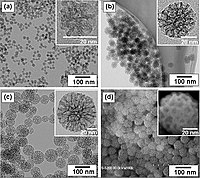
Photo from wikipedia
Inorganic two-dimensional semiconductor nanostructures intrigue the scientific community because of their tunable and sparse electronic states and their high conductivity. The current work deals with colloidal nanoplatelets (NPLs) based on… Click to show full abstract
Inorganic two-dimensional semiconductor nanostructures intrigue the scientific community because of their tunable and sparse electronic states and their high conductivity. The current work deals with colloidal nanoplatelets (NPLs) based on In2S3 compound, focusing on the growth mechanism that leads to the formation of two different phases, trigonal γ-In2S3 and defect spinel β-In2S3, both stabilized at room temperature and characterized by ordered metal voids. In particular, we substantiate the experimental factors (e.g., temperature, reaction duration, and surface ligands) that control the growth progress. The results indicated the formation of hexagonal NPLs of the γ-phase at an elevated temperature and dodecagon NPLs of the γ-phase at a lower temperature. A long-reaction duration time transformed the hexagons/dodecagons into truncated triangular shapes. Furthermore, the analysis of thermodynamic and kinetic factors indicated a phase transformation from the γ-phase to the β-phase. All phases were produce...
Journal Title: Chemistry of Materials
Year Published: 2019
Link to full text (if available)
Share on Social Media: Sign Up to like & get
recommendations!